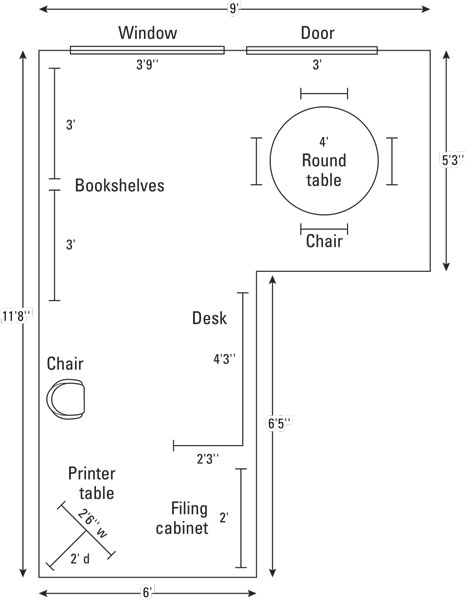Follow these steps to create a floor plan for your office space:
- Make a list of how you will use your space. Ask yourself these questions:
- Do I need a desk? If so, how much desk space do I need? What about a standing desk? They’re good for posture and they provide storage space beneath, which is often in short supply in smaller startup offices.
- Will I store paperwork and files in a central filing system or use some other method?
- Do I need storage space for inventory? Do I have a dedicated space for packing and shipping products?
- Will customers visit my office?
- Do I need working space for employees?
- Make a list of all your office furniture, equipment, and accessories (including office supplies and other items that should be stored but remain accessible).
If you’re sharing the space with others, make sure that you account for their belongings too. Or, if your office performs double duty as a bedroom or dining room, include on your list the non-work-related furniture that will remain in the room while you work. This is important at tax time when you want to take advantage of a home office deduction. The IRS wants to know exactly what percentage of your home is used exclusively for business purposes.
- On a sheet of paper, sketch out the dimensions of the room with lines that represent your walls, and then draw all your furniture and large office equipment in position within those walls. Rather than literally draw your furniture, you can draw different shapes and label them to help plan the placement of furniture, equipment, and designated work areas.
- Arrange the furniture and office equipment in a way that best meets your needs, based on the list you created in Step 1. This arrangement should be based on function.
After your room has been put on paper, based on how you want it to function, you can put the measurements to the test to confirm your furniture and equipment fit. This level of detail may seem like overkill, but it’s particularly important if you plan to lease office space (in which case, the less you need, the lower your overhead).
 Precise measurements ensure that everything fits in your space.
Precise measurements ensure that everything fits in your space.When you arrange your furniture, address storage needs for your office supplies. If you don’t have designated architectural space (such as a closet or built-in bookshelves), you’ll have to bring in storage (for example, file cabinets, baskets, and removable shelving).
- Measure all pieces of furniture and major equipment.
Using the room dimensions listed on your paper, compare measurements to see whether everything fits. If you run out of room, keep trying different arrangements until you find a floor plan that fits both your needs and your measurements.
Instead of working from a cramped home office all the time or leasing expensive office space, consider a shared coworking space, such as Regus or WeWork. Often found in larger cities (but quickly spreading to cities of all sizes), coworking spaces have open office areas designed for technology start-ups and other small businesses. These low-cost and flexible alternatives include standard needs, such as meeting spaces and Internet connectivity, and also boast extras, such as access to networking events with peers and investors, and are usually available on an as-needed basis.

